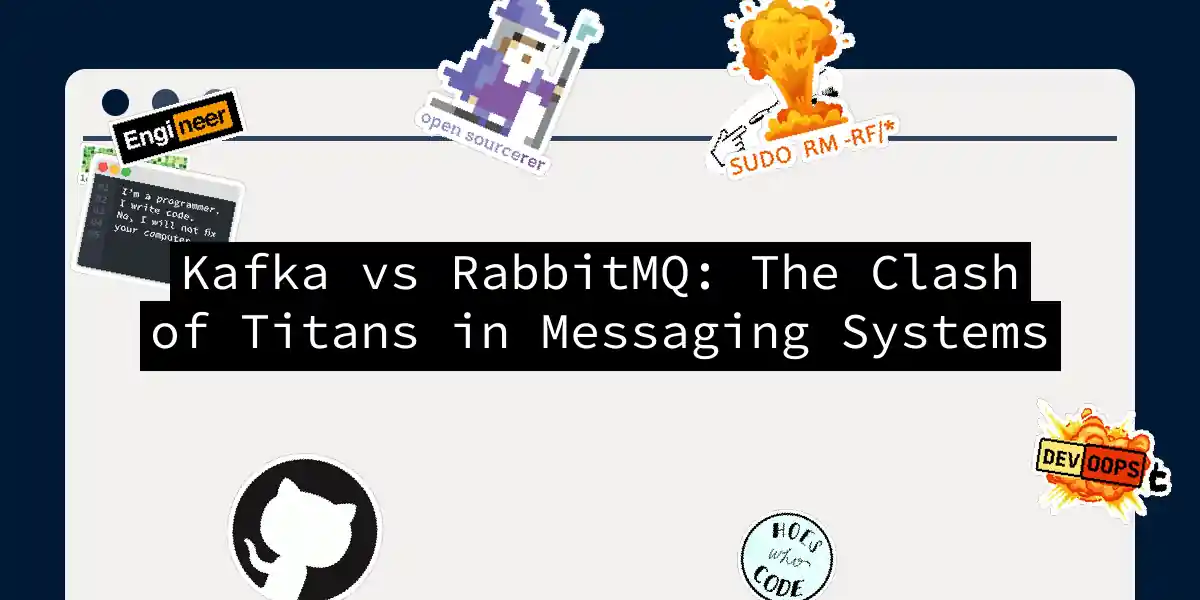Systems of Power
Imagine messaging systems like sports cars. Kafka is the Formula 1 — stripped down, optimized for raw speed, and built for straight-line sprints. RabbitMQ is the 4x4 off-roader — versatile, handles tricky terrain, and can carry more cargo. Both get you places, but choose wrong and you’ll be stuck in the mud.
Core Architectures
Kafka’s Architecture
- Distributed append-only log with automatic partitioning
- Producers push messages to topics → partitions → brokers
- Consumers pull data in batched offsets (pull-based)
- Built-in topic replication and offset management
RabbitMQ Architecture
- Message broker with AMQP/STOMP/MQTT support
- Exchanges route messages through bindings to queues
- Direct, topic, and fanout exchange types enable complex routing
- At-least once delivery guarantees with consumer acknowledgments
Speed Demons vs Precision Engineers
| Feature | Kafka | RabbitMQ |
|---|---|---|
| Scalability | Horizontal (add brokers) | Horizontal/vertical (node clusters) |
| Max Throughput | Billions messages/sec | Millions messages/sec |
| Latency | ~5ms at high load | ~1ms at low load |
| Message Ordering | Per partition (logging model) | None (queue per consumer) |
| Delivery Guarantees | At-least once (acks=all) | At-least once (positive acknowledgments) |
| Message Persistence | Default (log retention) | Optional (queue durability) |
Performance Benchmark
Under heavy load, Kafka handles 16x more throughput than RabbitMQ while maintaining reasonable latency. But RabbitMQ shines in low-latency scenarios where milliseconds matter.
The Art of Message Handling
Kafka Use Case: Real-Time Analytics Pipeline
from confluent_kafka import Producer
conf = {
'bootstrap.servers': 'kafka:9092',
'client.id': 'analytics_producer'
}
producer = Producer(conf)
# Produce message with key
producer.produce(
topic='user_activity',
key='user_123',
value='{"action": "login", "ts": "2023-10-18"}'
).get()
Key Considerations
- Use partition keys for data sharding
- Configure acks=all for guaranteed writes
- Monitor consumer lag in high-throughput scenarios
RabbitMQ Use Case: Microservices Coordination
import pika
# Producer
connection = pika.BlockingConnection()
channel = connection.channel()
channel.queue_declare(queue='orders')
channel.basic_publish(
exchange='',
routing_key='orders',
body='Order: #12345'
)
connection.close()
# Consumer
connection = pika.BlockingConnection()
channel = connection.channel()
channel.queue_declare(queue='orders')
def callback(ch, method, properties, body):
print(f"Order received: {body}")
channel.basic_consume(queue='orders', on_message_callback=callback)
Pro Tips
- Use dead-letter queues for error handling
- Implement consumer acknowledgments after processing
- Leverage exchange types for message filtering
When Speed Goes Wrong
Kafka Pitfalls
- Consumer lag: Too many partitions = partition leader elections
- Offset management: Losing offsets = message loss/replay
- Producer configurations:
acks=alltrades latency for reliability
RabbitMQ Pain Points
- Queue explosion: Unacked messages pile up in memory
- Complex routing: Over-engineered exchange/binding setups
- Node failure: Quorum queues need careful cluster management
The Verdict: Choose Your Weapon
My Final Take
Kafka feels like a space shuttle — overkill for elevator trajectories but essential for orbital insertions. RabbitMQ is the Swiss Army knife of messaging — less specialized but gets you out of most survival situations.
Choose based on your ego: Want to brag about handling 1M+ messages/sec? Kafka. Prefer solving real problems with clean code? RabbitMQ.
Flowchart
